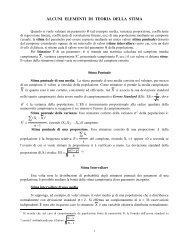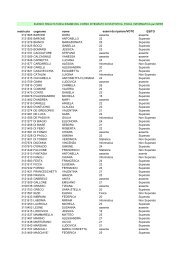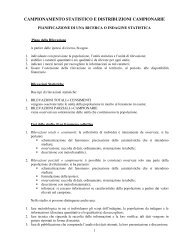Test t di Student - Biostatistica.unich.it
Test t di Student - Biostatistica.unich.it
Test t di Student - Biostatistica.unich.it
You also want an ePaper? Increase the reach of your titles
YUMPU automatically turns print PDFs into web optimized ePapers that Google loves.
Nel caso <strong>di</strong> due campioni in<strong>di</strong>pendenti si consideri il seguente esempio.<br />
ESEMPIO<br />
Ad un esame <strong>di</strong> statistica me<strong>di</strong>ca un campione <strong>di</strong> 30 studenti, che hanno<br />
frequentato le eserc<strong>it</strong>azioni, riportano un voto me<strong>di</strong>o <strong>di</strong> 27, un altro<br />
campione <strong>di</strong> 20 studenti, che non hanno frequentato le eserc<strong>it</strong>azioni,<br />
riporta come voto me<strong>di</strong>o 23; la varianze sono rispettivamente 9 e 8.5. Si<br />
verifichi l’ipotesi che la partecipazione alle lezioni non influisce sul voto.<br />
In<strong>di</strong>cando con µ 1 e µ 2 i valori me<strong>di</strong> incogn<strong>it</strong>i <strong>di</strong> tutti gli studenti, l’ipotesi<br />
nulla è:<br />
H 0 : µ 1 = µ 2<br />
cioe’ la frequenza non influisce sul voto.<br />
L’ipotesi alternativa è che la frequenza influisca pos<strong>it</strong>ivamente sul voto,<br />
ossia<br />
H 1 : µ > µ 0





